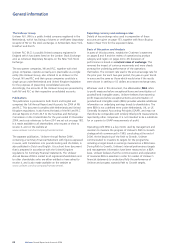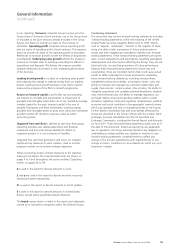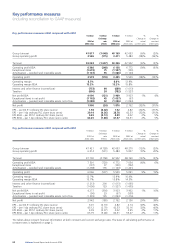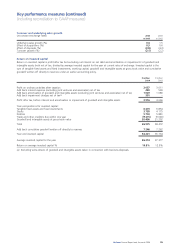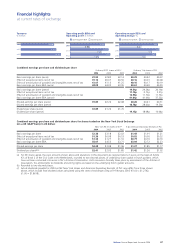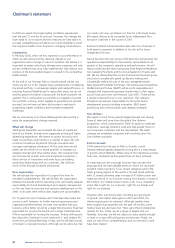Unilever 2004 Annual Report Download - page 15
Download and view the complete annual report
Please find page 15 of the 2004 Unilever annual report below. You can navigate through the pages in the report by either clicking on the pages listed below, or by using the keyword search tool below to find specific information within the annual report.12 Unilever Annual Report and Accounts 2004
About Unilever
(continued)
In spreads and cooking products, we extended pro•activ from
cholesterol-lowering spreads into milk, yoghurts and mini yoghurt
drinks. Like the original pro•activ spread, these new products are
all enriched with plant sterols.
In beverages, Lipton entered the healthy (‘functional’) water
segment in Europe with Aquae. In leaf tea, flavoured and herbal
tea extensions are being built on the ‘pyramid bag’ innovation,
and a campaign on tea antioxidants in the US is promoting the
health benefits of tea.
In response to the rising consumer trend in healthier eating, ice
cream has launched a wide range of ‘healthier options’ in all
regions. Our technology for the molecular control of ice cream
ingredients, which allows us to control ice cream ‘characteristics’
by controlling ice particles, gained regulatory approval in a further
six countries in 2004, enabling it to be launched in Asia and the
US. Our global roll-out of the technology continues.
Under the Hellmann’s, Wishbone, Calvé and Amora brands we
launched a series of innovations around Vitality, including
cholesterol-free mayonnaise in Mexico and extra light mayonnaise
in the UK. We also started a market test for chilled ready-to-eat
salads under the Hellmann's brand in the US.
We have responded to the emerging popularity of low-carb diets
in the US. We launched Carb Smart low-carb ice creams under
the Breyers, Klondike and Popsicle brands. A range of foods,
including dressings, peanut butter and snacks, were launched
under the Carb Options platform. A range of Carb Options
products were also launched in Australia, Canada and the UK.
We also launched the Optima range of bars and shakes under the
Slim•Fast brand.
Bertolli innovations included the relaunched pasta sauce range
and we also introduced a range of premium quality pasta sauces.
This is part of the transformation of Bertolli from an olive oil
brand to a world-leading Italian food brand.
Unilever filed a total of 370 new patent applications in 2004,
which will lead to innovations during 2005 and beyond.
Information technology
In 2004, there has been a continued drive towards a more
simplified business by standardising processes within our
transaction systems. Initiatives in Europe, Latin America, sub-
Saharan Africa and North America are progressing well.
The Latin American information, process and system
harmonisation and simplification programme - ‘Orchestra’,
advanced significantly during 2004. This has been deployed to
over 110 sites and 9 400 users in Brazil, Greater Andina, Chile,
River Plate and Mexico to cover 60% of the Latin American
business. The information management component of this
programme has won external recognition for excellence.
In Asia a demand and supply network planning tool is now live in
eleven countries, the Unilever standard data warehouse is
available in nine countries with twelve countries using the
regional e-Commerce hub.
Our sales force strategic automation technology – Siebel –
continues to be deployed across the business. Good progress has
been achieved in Asia and Latin America, using low-cost hand
held devices, sharing learning and best practice across regions. An
Asian trade funds management system has been implemented in
two units, with the rest of the region to follow in 2005/2006.
In North America we are participating in RFID (radio frequency
identification) pilots with Wal-Mart (working as one of their lead
suppliers) linked to our broader data synchronisation efforts to
improve the quality and speed of information sharing between us
and our customers.
We made further progress in the area of information
standardisation and management in support of global and
regional business processes. We remain committed to the active
support for industry data standardisation with strong involvement
in key initiatives, which include chairing the Global Data
Standards Network organisation, GDSN Inc.
Our outsourced voice, data and mobile communications
agreement with BT has been successfully implemented across the
globe, delivering both cost and service improvements. This has
proved to be a ground breaking and innovative partnership.
The Unilever Portal, a common entry and navigation software
technology, has been deployed to over 40 000 users in Europe
and 6 000 users in North America. In Europe this has enabled a
reduction of over 50 traditional intranet sites. We have agreed
upon a global licensing of this technology and will continue
deployment to establish one environment for information and
access within Unilever.
Environment
We improved our performance in managing the impact of our
manufacturing activities on the environment, and our three
sustainability initiatives – agriculture, fish and water – continue
to make good progress.
Our manufacturing operations use seven parameters to measure
the emissions from our factories and set targets for eco-efficiency.
In 2003 (latest available figures) we continued to improve on our
2002 performance, meeting four of our targets. We failed to hit
our targets for hazardous and non-hazardous waste and CO2
from energy emissions.
We have reduced the unit load of sulphur oxides emitted from
our factories by 64% since 1995. We have also made significant
reductions in energy and water consumption and reduced the
levels of waste generated by our operations.


